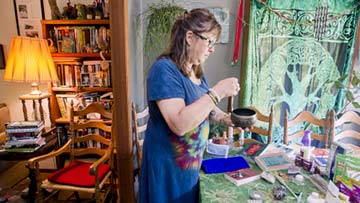Death midwives take care of loved ones after they die
USA – Laura Fry only knew the first man she helped die as “dad.” The 72-year-old man’s lungs and bones were riddled with cancer, leaving him in a constant agony that was taking a toll on his mind. To help their angry and frightened father, the children turned to Fry, a certified death midwife.
As a death midwife, or death doula, Fry’s job is to provide emotional, physical and sometimes religious and medical support to the dying and their families.
“I went out and I held his hand. I said ‘What are you afraid of? This is nothing to be afraid of. This is something you have lived all your life for. This is not the end, this is the beginning,’ ” Frey recalled. “None of us get out of this alive.”
He died two days later.
Since that first time three years ago, Fry has helped three other families with a dying loved one.
She’s is part of a fledgling nationwide movement trying to reclaim care for the dying and the dead. Death midwives and proponents of home funerals strive to remove some of the business-minded aspects of death. Akin to the home birth movement of the 1980s, advocates say dying and the hours or days afterward should be a personal, intimate experience people are allowed to have at home.
“We take such good care of people from birth up until that point, and then we turn it over to strangers. That seems strange to me,” Fry said.
As opposed to a traditional funeral that entails a family relinquishing their loved one to a funeral home, a home funeral allows keeping someone home for one to three days after they die, said National Home Funeral Alliance spokeswoman Kateyanne Unullisi. In many cases, the family bathes and dress as their dead loved one, anoints them with oils and prays over them before the person is buried or cremated.
“It’s a liminal time,” Unullisi said. “There’s a very interesting space you’re in. You are with someone you loved and they’re dead and you’re sad. But you’re also with them. It’s a very healing thing to do.”
Another factor is cost. According to the Illinois Funeral Director’s Association, a traditional funeral averages about $7,000. Unullisi said a home funeral can cost $200.
It’s unclear how many people opt for home funerals because they’re private affairs and there’s no agency tracking them, she said. But Unullisi believes it’s a growing movement based on her group’s membership, which has jumped nearly 70 percent to 700 members in the past year.
She said home funerals are legal in all 50 states, although nine states, including Illinois, pose some restrictions on who has to be responsible for a dead body. In Illinois, the law requires a funeral home director oversee the care. Beyond the death certificate, there’s paperwork involved depending on where the death takes place that a funeral director has to sign.
The challenge is in finding a funeral home director who’s willing to hand over some of their typical duties to the family, proponents say.
But Bob Smith, regional director for the Illinois Funeral Director’s Association territory that includes McHenry County, said he knows funeral directors who would assist if a family wanted to host a wake or funeral at home.
Still, he acknowledged some funeral home directors might feel death midwives or home funeral supporters are infringing on their jobs. Plus, he said, a funeral director can be helpful when a grieving family doesn’t want to deal with the minutia of filing the necessary paperwork.
“As far as I’m concerned, we’re here to help people. We’re not here to create problems,” Smith said. “As long as we can stay within the legal guidelines, we will do what a family wants.”
Although some might say a home funeral is more personal and emotionally satisfying, it also requires some pragmatic work.
Unullisi said beyond washing and dressing the body, family members should place bags of rice on the person’s eyes so they stay closed. She also advised using a silk tie around the head to keep the mouth closed.
“You need five to eight people really on it,” Unullisi said. “Not all around the body. You need to assign work out to people. …You need a community around you.”
Some funeral directors question if death midwives and home funeral guides have enough training to deal with some of these things, Smith said.
Fry went through a weekend of training from a certified death midwife and home funeral guide based out of Seattle four years ago. In some ways, the experience that inspired her to become a death midwife also prepared her.
She, along with her sisters, had cared for their mother, Joan Brady, for about eight hours after she died of head and neck cancer on Christmas Day 2000. They washed her, anointed her with oils and said a poem before turning her over to a funeral home.
“It was the natural thing to do,” Fry said. “I think that’s what we would like people to get back to. The natural way of doing things.”
Photo by Sarah Nader


Leave a Comment
You must be logged in to post a comment.